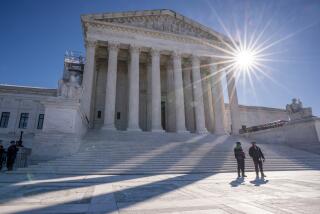Ito’s Law: Keeping Control of Courtroom
- Share via
Welcome to Superior Court Judge Lance A. Ito’s world of no-comfort journalism.
The judge has created a Spartan work space for the more than 100 reporters covering selection of a jury for O.J. Simpson’s murder trial. When Ito and the lawyers resume questioning prospective jurors today, the journalists will crowd into four rooms, one 12-by-16 feet and the others even smaller.
Only five pool reporters are allowed into the courtroom during selection. So the rest must be confined to the four rooms if they want to hear the audio feed.
Because there’s no furniture, they’ll have to either sit on the floor or bring in their own folding chairs. The room has no phone lines, so reporters will have to pack their laptop computers to another room to file stories. Metal detectors will be installed to make sure the reporters are not carrying tape recorders or cellular phones. That’s necessary to assure obedience to a State Judicial Council rule against photographing jurors or recording or broadcasting what they say.
Although the judge has been mad at the press lately for printing various scoops, leaks and mistakes, this uncomfortable arrangement isn’t Ito’s revenge. Rather, it’s a graphic example of how he is constantly walking the line between assuring an open trial, guaranteeing Simpson a fair hearing in court and protecting the jurors.
*
Tuesday morning, I watched Ito visit the press quarters on the 12th floor of the Criminal Courts Building to check the quality of the sound coming from his courtroom, three floors below.
*
He’d taken off his black judicial robe and was wearing a blue suit. He carried a stenographer’s notebook. Television crews crowded around him, and a soundman accidentally brushed the top of Ito’s head with a boom microphone. That drew a chuckle from Ito, his only smile of the visit.
It was my first sight of the judge at close range, and I was intimidated. Reporters routinely treat presidents with contempt and rudely shout questions at the Pope. But some of us in the room didn’t dare complain to Ito about the working conditions or about any other matters that might be on our minds. After all, he has threatened to pull the plug on television coverage, temporarily barred the Los Angeles Daily News from the courtroom, and most recently canceled his subscription to the Daily Journal, a legal publication, because he didn’t like a profile of a fellow judge.
*
After the judge left, I talked to a more approachable person about the arrangements Ito had ordered. He’s Scott Shulman, who is in charge of media technical facilities for the trial.
They were designed to make sure the sound feed from the courtroom was not broadcast by some scoop-happy television or radio station. During the federal trial of the police officers charged with beating Rodney King, a television station ignored a judge’s no-broadcasting order, picking up the courtroom audio feed with a pressroom telephone. To make that impossible in the Simpson case, Ito moved the press into the rooms without phones.
Not only that, but Shulman has made him a “kill switch” so that the judge can cut off all sound from the courtroom if his orders are disobeyed.
“I think if I were a judge, I would want a kill switch to give me control over what comes out of the audio,” Shulman said.
*
The word control is important in understanding Judge Ito’s arrangements for the press.
It was lack of judicial control over the courtroom that led the U.S. Supreme Court to throw out the 1954 murder conviction of Dr. Sam Sheppard, whose Cleveland trial set the standard for ugly and undisciplined press coverage. The late Justice Tom Clark’s opinion in the Sheppard case is the defining legal word on control of outrageous press coverage of trials.
I don’t know whether Ito has studied the case recently, but it sounds like he’s taking Clark’s admonitions to heart.
Clark was disdainful of the Sheppard trial judge. “The trial court,” he wrote, “failed to invoke procedures which would have guaranteed petitioner a fair trial, such as adopting stricter rules for use of the courtroom as petitioner’s counsel requested, limiting their number and more closely supervising their courtroom conduct. . . . The carnival atmosphere at trial could easily have been avoided since the courtroom and courthouse premises are subject to control of the court.”
Ito also knows that the young lawyer who successfully carried Sheppard’s case to the Supreme Court is now a veteran attorney and member of the Simpson defense team, F. Lee Bailey.
Judge Ito, I’m sure, doesn’t want the Simpson trial to go the way of Sheppard’s, to be ignominiously thrown out by the nation’s highest court because the judge lost control.
That helps explain the cramped rooms the press must endure during jury selection. And what of the reporters’ discomfort? “I think it’s good for people,” said consultant Shulman, whose regular job is with KABC Channel 7. “It’s refreshing.”
More to Read
Sign up for Essential California
The most important California stories and recommendations in your inbox every morning.
You may occasionally receive promotional content from the Los Angeles Times.












